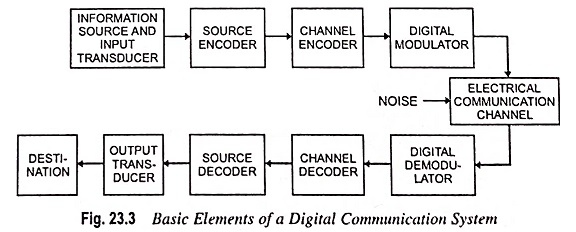Basic Elements of Digital Communication System:
Figure 23.3 shows the functional diagram and the basic elements of digital communication system. The source output may be either an analog signal like audio or video signal, or a digital signal, such as the output of a teletype machine, that is discrete in time and has a finite number of output characters. In a digital communication system, the messages generated by the source are converted into a sequence of binary digits. Ideally, we should like to represent the source output (message) by as few binary digit as possible. The process of efficiently converting the output of either an analog or digital source into a sequence of binary digits is called the source encoding or data compression.
The sequence of binary digits from the source encoder, called the information sequence, is passed to the channel encoder. The channel encoder is used to introduce some redundancy in the binary information sequence that can be used at the receiver to overcome the effects of noise and interference encountered in the transmission of the signal through the electrical communication channel. Thus, the added redundancy increases the reliability of the received data and improves the fidelity of the received signal. Redundancy in the information sequence helps the receiver in decoding the desired information sequence. For example, a (trivial) form of encoding of the binary sequence is simply to repeat each binary digit m times, where m is some positive integer. More sophisticated (non-trivial) encoding involves taking k information bits at a time and mapping each k-bit sequence into a unique n-bit sequence, called a code word. The amount of redundancy introduced by encoding the data in this manner is measured by the ratio n/k. The reciprocal of this ratio is called the rate of code or simply the code rate.
The channel encoder output goes to the digital modulator, which acts as the interface to the communication channel. The main function of the digital modulator is to convert the binary information sequence into signal waveforms. The electrical communication channel is the physical medium that is used to send the signal from the transmitter to the receiver. In wireless transmission, the free space (atmosphere) may be the communication channel. On the other hand, telephone channels usually make use of a variety of physical media, including wire lines, optical fibre cables, and wireless (microwave radio). The signal is corrupted in a random manner by a variety of possible mechanism, such as additive thermal noise produced by electronic devices, man-made noise e.g., automobile ignition noise, and atmospheric noise, e.g., electrical lightning discharges during thunderstorms when it is transmitted through any type of channel.
This corrupted signal is produced by the digital demodulator at the receiving end of a elements of digital communication system and the waveform is reduced to a sequence of number that represents estimates of the transmitted data symbols (binary or higher number system). This sequence of numbers is passed to the channel decoder which reconstructs the original information sequence from the knowledge of the code used by the channel encoder and the redundancy contained in the received data.
The frequency of errors occurred in the decoded sequence is a measure of how well the demodulator and decoder perform. The average probability of a bit error at the output of the decoder is a measure of the performance of the demodulator-decoder combination. In general, the probability of error is a function of the code characteristics, type of waveform used to transmit the information over the channel, the transmitter power, the characteristics of the channel i.e., the amount of noise, the nature of interference, etc., and the method of demodulation and decoding.
Finally, when an analog output is desired, the source decoder accepts the output sequence from the channel decoder and, from the knowledge of the source encoding method used, reconstructs the original signal from the source. Due to channel decoding errors and possible distortion introduced by the source encoder and the source decoder, the signal at the output of the source decoder is an approximation to the original source output. The difference or some function of difference between the original and the reconstructed signals is a measure of the distortion introduced by the elements of digital communication system.
